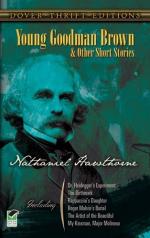|
This section contains 7,164 words (approx. 24 pages at 300 words per page) |

|
SOURCE: "Hawthorne's 'Young Goodman Brown': Early Nineteenth-Century and Puritan Constructions of Gender," in The New England Quarterly, Vol. LXIX, No. 1, March, 1996, pp. 33-55.
In this essay, Keil examines "Young Goodman Brown" in terms of nineteenth-century views concerning masculinity and femininity.
Nathaniel Hawthorne's "Young Goodman Brown" traditionally has been read as an examination of crises of faith, morality, and/or psychosexuality. Early readings focused on questions of theology and conduct, but since the opening years of the 1950s, a second category of readings has emphasized the psychosexual elements. Roy Male, for example, argued [in Hawthorne's Tragic Vision, 1957] that "the dark night in the forest is essentially a sexual experience, though it is also much more," while Frederick Crews observed [in The Sins of the Fathers: Hawthorne's Psychological Themes, 1966] that in his dream experience, the young, newly wed, and still oedipal Brown, fleeing from the sexuality of married love, removes...
|
This section contains 7,164 words (approx. 24 pages at 300 words per page) |

|


